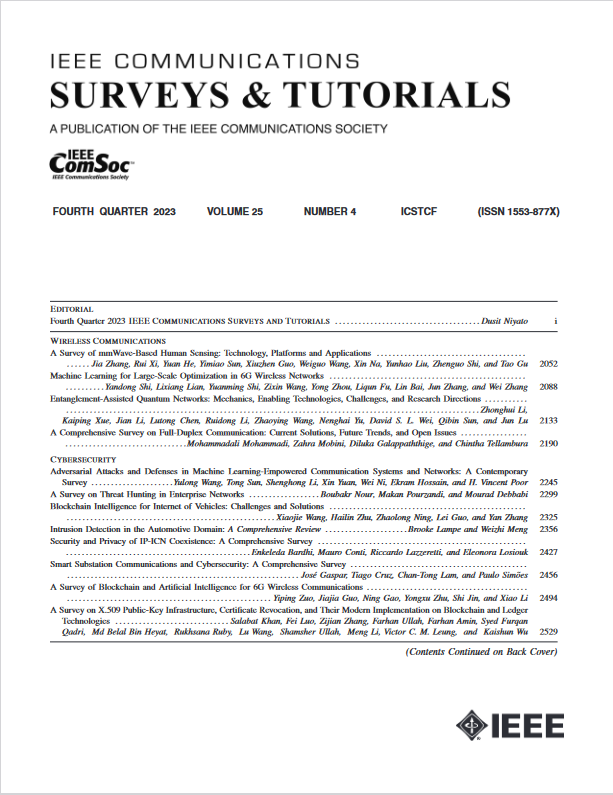Breaking the Interference and Fading Gridlock in Backscatter Communications: State-of-the-Art, Design Challenges, and Future Directions
IF 34.4
1区 计算机科学
Q1 COMPUTER SCIENCE, INFORMATION SYSTEMS
引用次数: 0
Abstract
As the Internet of Things (IoT) advances by leaps and bounds, a multitude of devices are becoming interconnected, marking the onset of an era where everything is connected. While this growth opens up opportunities for novel products and applications, it also leads to increased energy reliance on IoT devices, creating a significant bottleneck that hinders sustainable progress. Backscatter communication (BackCom), as a low-power and passive communication technology, emerges as one of the promising solutions to this energy impasse by reducing the manufacturing cost and energy consumption for IoT devices. However, BackCom systems also face some challenges, such as complex interference environments, including the direct-link interference (DLI) and the mutual interference (MI) between tags, which severely disrupt the efficiency of BackCom networks. Moreover, the double-path fading is another major issue that leads to a degraded system performance. To fully unleash the potential of BackComs, the purpose of this paper is to furnish a comprehensive review of existing solutions with a focus on addressing these challenges, offering an insightful analysis and comparison of various strategies. Specifically, we begin by introducing the preliminaries for BackCom, including its history, operating mechanisms, main architectures, etc., providing a foundational understanding of this field. Then, we delve into fundamental issues related to BackCom systems, such as solutions for the DLI, the MI, and the double-path fading. This paper thoroughly provides state-of-the-art advances for each case, particularly highlighting how the latest innovations in theoretical approaches and system design can strategically address these challenges. Finally, we explore emerging trends and challenges in BackComs by forecasting potential technological advancements and providing insights and guidelines for navigating the intricate landscape of future communication needs in a rapidly evolving IoT ecosystem.打破反向散射通信中的干扰和衰减僵局:最新技术、设计挑战和未来方向
随着物联网(IoT)的突飞猛进,大量设备开始相互连接,标志着万物互联时代的开始。虽然这种增长为新产品和应用开辟了机会,但它也导致对物联网设备的能源依赖增加,从而形成阻碍可持续发展的重大瓶颈。反向散射通信(BackCom)作为一种低功耗无源通信技术,通过降低物联网设备的制造成本和能耗,成为解决这种能源僵局的有前途的解决方案之一。然而,BackCom系统也面临着一些挑战,如复杂的干扰环境,包括直接链路干扰(direct-link interference, DLI)和标签之间的互干扰(mutual interference, MI),严重影响了BackCom网络的效率。此外,双径衰落是导致系统性能下降的另一个主要问题。为了充分发挥backcom的潜力,本文的目的是对现有解决方案进行全面回顾,重点关注应对这些挑战,并对各种策略进行有见地的分析和比较。具体来说,我们首先介绍了BackCom的基础知识,包括它的历史、运行机制、主要架构等,提供了对该领域的基本了解。然后,我们深入研究了与BackCom系统相关的基本问题,例如DLI, MI和双径衰落的解决方案。本文全面介绍了每个案例的最新进展,特别强调了理论方法和系统设计的最新创新如何从战略上解决这些挑战。最后,我们通过预测潜在的技术进步,并为在快速发展的物联网生态系统中导航未来通信需求的复杂景观提供见解和指南,探索backcom的新兴趋势和挑战。
本文章由计算机程序翻译,如有差异,请以英文原文为准。
求助全文
约1分钟内获得全文
求助全文
来源期刊

IEEE Communications Surveys and Tutorials
COMPUTER SCIENCE, INFORMATION SYSTEMS-TELECOMMUNICATIONS
CiteScore
80.20
自引率
2.50%
发文量
84
审稿时长
6 months
期刊介绍:
IEEE Communications Surveys & Tutorials is an online journal published by the IEEE Communications Society for tutorials and surveys covering all aspects of the communications field. Telecommunications technology is progressing at a rapid pace, and the IEEE Communications Society is committed to providing researchers and other professionals the information and tools to stay abreast. IEEE Communications Surveys and Tutorials focuses on integrating and adding understanding to the existing literature on communications, putting results in context. Whether searching for in-depth information about a familiar area or an introduction into a new area, IEEE Communications Surveys & Tutorials aims to be the premier source of peer-reviewed, comprehensive tutorials and surveys, and pointers to further sources. IEEE Communications Surveys & Tutorials publishes only articles exclusively written for IEEE Communications Surveys & Tutorials and go through a rigorous review process before their publication in the quarterly issues.
A tutorial article in the IEEE Communications Surveys & Tutorials should be designed to help the reader to become familiar with and learn something specific about a chosen topic. In contrast, the term survey, as applied here, is defined to mean a survey of the literature. A survey article in IEEE Communications Surveys & Tutorials should provide a comprehensive review of developments in a selected area, covering its development from its inception to its current state and beyond, and illustrating its development through liberal citations from the literature. Both tutorials and surveys should be tutorial in nature and should be written in a style comprehensible to readers outside the specialty of the article.
 求助内容:
求助内容: 应助结果提醒方式:
应助结果提醒方式:


